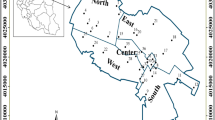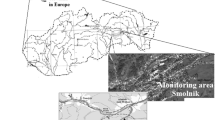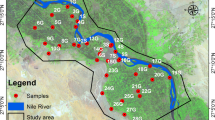Abstract
Exposure to heavy metals through drinking water can cause significant adverse health effects. The aim of the present study was to investigate the concentration, spatial distribution, and assessment of non-carcinogenic risk attributed to exposure to arsenic (As), chromium (Cr), cadmium (Cd), and lead (Pb) in rural areas of eight cities of the West Azerbaijan province of Iran. Eighty-five water samples were taken from randomly selected drinking water wells in the rural areas, and the concentration of the heavy metals was measured by using standard methods. The concentration distribution maps were drawn, and the non-carcinogenic health risks for ingestion and dermal exposure pathways were calculated in four age groups (including infants, children, teenagers, and adults). According to the obtained results, arsenic is considered as the most worrying pollutant among the investigated heavy metals. The maximum measured concentration for arsenic was 371.9 μg/L, which is 37 times the maximum permissible limit. The results of the health risk assessment illustrate that exposure to heavy metals via dermal contact do not pose significant non-carcinogenic risks. However, the calculated non-carcinogenic risks for oral exposure to arsenic were very high and concerning. The highest hazard quotient for oral exposure to arsenic was related to rural of city G (82.64). It is recommended to take the necessary measures as soon as possible regarding the supply of safe drinking water in the studied areas.



Similar content being viewed by others
References
Adimalla N (2020) Spatial distribution, exposure, and potential health risk assessment from nitrate in drinking water from semi-arid region of South India. Hum Ecol Risk Assess Int J 26:310–334
Åkesson A, Bjellerup P, Lundh T, Lidfeldt J, Nerbrand C, Samsioe G, Skerfving S, Vahter M (2006) Cadmium-induced effects on bone in a population-based study of women. Environ Health Perspect 114:830–834
Aluko T, Njoku K, Adesuyi A, Akinola M (2018) Health risk assessment of heavy metals in soil from the iron mines of Itakpe and Agbaja, Kogi State, Nigeria. Pollution 4:527–538
Amodio-Cocchieri R (1996) Lead in human blood from children living in Campania, Italy. J Toxicol Environ Health A 47:311–320
Annapoorna H, Janardhana M (2015) Assessment of groundwater quality for drinking purpose in rural areas surrounding a defunct copper mine. Aquatic Procedia 4:685–692
Apostoli P, Kiss P, Porru S, Bonde JP, Vanhoorne M (1998) Male reproductive toxicity of lead in animals and humans. ASCLEPIOS Occupational Environ Med 55:364
Baird R, Rice E, Eaton A (2017) Standard methods for the examination of water and wastewaters. Water Environment Federation, Chair Eugene W. Rice, American Public Health Association Andrew D. Eaton, American Water Works Association
Barzegar R, Asghari Moghaddam A, Adamowski J, Nazemi AH (2019) Assessing the potential origins and human health risks of trace elements in groundwater: a case study in the Khoy plain. Iran Environ Geochem Health 41:981–1002
Bertin G, Averbeck D (2006) Cadmium: cellular effects, modifications of biomolecules, modulation of DNA repair and genotoxic consequences (a review). Biochimie 88:1549–1559
Boateng TK, Opoku F, Acquaah SO, Akoto O (2016) Groundwater quality assessment using statistical approach and water quality index in Ejisu-Juaben Municipality, Ghana. Environmental Earth Sci 75:1–14
Carver A, Gallicchio VS (2018) Heavy metals and cancer. Cancer causing substances. IntechOpen
Centeno JA, Tchounwou PB, Patlolla AK, Mullick FG, Murakata L, Meza E, TodorTodorov DL, Yedjou CG (2006) Environmental pathology and health effects of arsenic poisoning. In Managing arsenic in the environment: from soil to human health. CSIRO, pp 311–327
Chowdhury S, Mazumder MJ, Al-Attas O, Husain T (2016) Heavy metals in drinking water: occurrences, implications, and future needs in developing countries. Sci Total Environ 569:476–488
Dayan A, Paine A (2001) Mechanisms of chromium toxicity, carcinogenicity and allergenicity: review of the literature from 1985 to 2000. Hum Exp Toxicol 20:439–451
Demir V, Dere T, Ergin S, Cakır Y, Celik F (2015) Determination and health risk assessment of heavy metals in drinking water of Tunceli, Turkey. Water Resour 42:508–516
Demirak A, Yilmaz F, Tuna AL, Ozdemir N (2006) Heavy metals in water, sediment and tissues of Leuciscus cephalus from a stream in southwestern Turkey. Chemosphere 63:1451–1458
Dinse GE, Umbach DM, Sasco AJ, Hoel DG, Davis DL (1999) Unexplained increases in cancer incidence in the United States from 1975 to 1994: possible sentinel health indicators? Annu Rev Public Health 20:173–209
Duruibe JO, Ogwuegbu M, Egwurugwu J (2007) Heavy metal pollution and human biotoxic effects. Int J Physical Sci 2:112–118
Elumalai V, Brindha K, Lakshmanan E (2017) Human exposure risk assessment due to heavy metals in groundwater by pollution index and multivariate statistical methods: a case study from South Africa. Water 9:234
Esmaeili S, Asghari Moghaddam A, Barzegar R, Tziritis E (2018) Multivariate statistics and hydrogeochemical modeling for source identification of major elements and heavy metals in the groundwater of Qareh-Ziaeddin plain, NW Iran. Arab J Geosci 11:1–14
Fallahzadeh RA, Ghaneian MT, Miri M, Dashti MM (2017) Spatial analysis and health risk assessment of heavy metals concentration in drinking water resources. Environ Sci Pollut Res 24:24790–24802
Fernandez-Luqueno F, Lopez-Valdez F, Gamero-Melo P, Luna-Suarez S, Aguilera-Gonzalez EN, Martínez AI, García-Guillermo M, Hernandez-Martinez G, Herrera-Mendoza R, Álvarez-Garza MA (2013) Heavy metal pollution in drinking water-a global risk for human health: a review. Afr J Environ Sci Technol 7:567–584
Fu Z, Xi S (2020) The effects of heavy metals on human metabolism. Toxicol Mech Methods 30:167–176
Ghorbani M (2021) The geology of Iran: tectonic, magmatism and metamorphism. Springer
Goyer RA, Clarkson TW (1996) Toxic effects of metals. Casarett and Doull’s Toxicol: Basic Sci Poisons 5:691–736
Henson MC, Chedrese PJ (2004) Endocrine disruption by cadmium, a common environmental toxicant with paradoxical effects on reproduction. Exp Biol Med 229:383–392
Hertz-Picciotto I (2000) The evidence that lead increases the risk for spontaneous abortion. Am J Ind Med 38:300–309
Hughes MF (2002) Arsenic toxicity and potential mechanisms of action. Toxicol Lett 133:1–16
Jidon A (1993) Skin cancer caused by chronic arsenical poisoning-a report of three cases. Med J Malaysia 48:87
Kamunda C, Mathuthu M, Madhuku M (2016) Health risk assessment of heavy metals in soils from Witwatersrand Gold Mining Basin, South Africa. Int J Environ Res Public Health 13:663
Kaul B, Sandhu RS, Depratt C, Reyes F (1999) Follow-up screening of lead-poisoned children near an auto battery recycling plant, Haina, Dominican Republic. Environ Health Perspect 107:917–920
Khalid S, Shahid M, Shah AH, Saeed F, Ali M, Qaisrani SA, Dumat C (2020) Heavy metal contamination and exposure risk assessment via drinking groundwater in Vehari, Pakistan. Environ Sci Pollut Res 27:39852–39864
Khan S, Rauf R, Muhammad S, Qasim M, Din I (2016) Arsenic and heavy metals health risk assessment through drinking water consumption in the Peshawar District, Pakistan. Hum Ecol Risk Assess Int J 22:581–596
Kim J-J, Kim Y-S, Kumar V (2019) Heavy metal toxicity: an update of chelating therapeutic strategies. J Trace Elem Med Biol 54:226–231
Kurwadkar S, Kanel SR, Nakarmi A (2020) Groundwater pollution: occurrence, detection, and remediation of organic and inorganic pollutants. Water Environ Res 92:1659–1668
Larsson SC, Orsini N, Wolk A (2015) Urinary cadmium concentration and risk of breast cancer: a systematic review and dose-response meta-analysis. Am J Epidemiol 182:375–380
Lei L, Liang D, Yu D, Chen Y, Song W, Li J (2015) Human health risk assessment of heavy metals in the irrigated area of Jinghui, Shaanxi, China, in terms of wheat flour consumption. Environ Monit Assess 187:1–13
Li K, Cui S, Zhang F, Hough R, Fu Q, Zhang Z, Gao S, An L (2020) Concentrations, possible sources and health risk of heavy metals in multi-media environment of the Songhua River, China. Int J Environ Res Public Health 17:1766
Lim JT, Tan YQ, Valeri L, Lee J, Geok PP, Chia SE, Ong CN, Seow WJ (2019) Association between serum heavy metals and prostate cancer risk–a multiple metal analysis. Environ Int 132:105109
Mahdavi T (2021) Evaluation of quantitative and qualitative sustainability of aquifers by groundwater footprint methodology: case study: West Azerbaijan Province. Iran Environ Monitoring Ass 193:368
Malakootian M, Mohammadi A, Faraji M (2020) Investigation of physicochemical parameters in drinking water resources and health risk assessment: a case study in NW Iran. Environmental Earth Sci 79:1–11
Maleki A, Jari H (2021) Evaluation of drinking water quality and non-carcinogenic and carcinogenic risk assessment of heavy metals in rural areas of Kurdistan, Iran. Environmental Technol Innov 23:101668
Martinez-Campa C, Alonso-Gonzalez C, Mediavilla M, Cos S, Gonzalez A, Ramos S, Sánchez-Barceló E (2006) Melatonin inhibits both ERα activation and breast cancer cell proliferation induced by a metalloestrogen, cadmium. J Pineal Res 40:291–296
Mirzabeygi M, Abbasnia A, Yunesian M, Nodehi RN, Yousefi N, Hadi M, Mahvi AH (2017) Heavy metal contamination and health risk assessment in drinking water of Sistan and Baluchistan, Southeastern Iran. Hum Ecol Risk Assess Int J 23:1893–1905
Mohammadi A, Hajizadeh Y, Taghipour H, Mosleh Arani A, Mokhtari M, Fallahzadeh H (2018) Assessment of metals in agricultural soil of surrounding areas of Urmia Lake, northwest Iran: a preliminary ecological risk assessment and source identification. Hum Ecol Risk Assess Int J 24:2070–2087
Mohammadi AA, Zarei A, Majidi S, Ghaderpoury A, Hashempour Y, Saghi MH, Alinejad A, Yousefi M, Hosseingholizadeh N, Ghaderpoori M (2019) Carcinogenic and non-carcinogenic health risk assessment of heavy metals in drinking water of Khorramabad. Iran Methodsx 6:1642–1651
Muhammad S, Shah MT, Khan S (2011) Health risk assessment of heavy metals and their source apportionment in drinking water of Kohistan region, northern Pakistan. Microchem J 98:334–343
Nachman KE, Ginsberg GL, Miller MD, Murray CJ, Nigra AE, Pendergrast CB (2017) Mitigating dietary arsenic exposure: current status in the United States and recommendations for an improved path forward. Sci Total Environ 581:221–236
Negaresh H, Faizi V, Hodaei AA, Mollashahi M, Shahhiseini M (2013) Zoning of mass movement occurrence hazard in West Azarbaijan Province. J Natural Environmental Hazards 2:29–43
Nordberg G, Goyer R, Nordberg M (1975) Comparative toxicity of cadmium-metallothionein and cadmium chloride on mouse kidney. Arch Pathol 99:192–197
O’Brien TJ, Ceryak S, Patierno SR (2003) Complexities of chromium carcinogenesis: role of cellular response, repair and recovery mechanisms. Mutation Res/fundamental Molecular Mechanisms Mutagenesis 533:3–36
Pacyna JM (2023): Monitoring and assessment of metal contaminants in the air. In: Toxicology of Metals, vol 1. CRC Press, pp 9–28
Pershagen G (1981) The carcinogenicity of arsenic. Environ Health Perspect 40:93–100
Postigo C, Martinez DE, Grondona S, Miglioranza KSB (2018): Groundwater pollution: sources, mechanisms, and prevention.
Radfarda M, Gholizadehc A, Azhdarpoorb A, Badeenezhada A, Mohammadid AA, Yousefie M (2019) Health risk assessment to fluoride and nitrate in drinking water of rural residents living in the Bardaskan city, arid region, southeastern Iran. Water Treat 145:249–256
Rashidi M, Alavipanah SK (2016) Relation between kidney cancer and soil leads in Isfahan Province, Iran between 2007 and 2009. J Cancer Res Ther 12:716
Rausand M (2013) Risk assessment: theory, methods, and applications, 115. John Wiley & Sons
Rehman K, Fatima F, Waheed I, Akash MSH (2018) Prevalence of exposure of heavy metals and their impact on health consequences. J Cell Biochem 119:157–184
Rice EW, Baird RB, Eaton AD, Clesceri LS (2012) Standard methods for the examination of water and wastewater, 10. American public health association Washington, DC
Saleh HN, Panahande M, Yousefi M, Asghari FB, Oliveri Conti G, Talaee E, Mohammadi AA (2019) Carcinogenic and non-carcinogenic risk assessment of heavy metals in groundwater wells in Neyshabur Plain. Iran Biol Trace Element Res 190:251–261
Samadi MT, Khorsandi H, Bahrami Asl F, Poorolajal J, Tayebinia H (2020) The effect of long-term exposures to hypersaline particles originated from drying Urmia hypersaline Lake on the increased cardiovascular risks in the villagers around the Lake. Hum Ecol Risk Assess Int J 26:335–348
Schutte R, Nawrot TS, Richart T, Thijs L, Vanderschueren D, Kuznetsova T, Van Hecke E, Roels HA, Staessen JA (2008) Bone resorption and environmental exposure to cadmium in women: a population study. Environ Health Perspect 116:777–783
Shams M, Tavakkoli Nezhad N, Dehghan A, Alidadi H, Paydar M, Mohammadi AA, Zarei A (2022) Heavy metals exposure, carcinogenic and non-carcinogenic human health risks assessment of groundwater around mines in Joghatai. Iran Int J Environmental Anal Chem 102:1884–1899
Siddiqui M, Singh S, Mehrotra P, Singh K, Sarangi R (2006) Comparison of some trace elements concentration in blood, tumor free breast and tumor tissues of women with benign and malignant breast lesions: an Indian study. Environ Int 32:630–637
Sohrabi N, Kalantari N, Amiri V, Saha N, Berndtsson R, Bhattacharya P, Ahmad A (2021) A probabilistic-deterministic analysis of human health risk related to the exposure to potentially toxic elements in groundwater of Urmia coastal aquifer (NW of Iran) with a special focus on arsenic speciation and temporal variation. Stoch Env Res Risk Assess 35:1509–1528
Tchounwou PB, Yedjou CG, Patlolla AK, Sutton DJ (2012) Heavy metal toxicity and the environment. Mol Clin Environ Toxicol 3:133–164
Wongsasuluk P, Chotpantarat S, Siriwong W, Robson M (2014) Heavy metal contamination and human health risk assessment in drinking water from shallow groundwater wells in an agricultural area in Ubon Ratchathani province, Thailand. Environ Geochem Health 36:169–182
Funding
This work was supported by the Urmia University of Medical Sciences, Grant No.: 10913. Farshad Bahrami Asl has received research support from Urmia University of Medical Sciences.
Author information
Authors and Affiliations
Contributions
All authors contributed to the study’s conception and design. Concentration measurements were performed by Farshad Bahrami Asl and Elnaz Alipour. Data analysis and modeling were performed by Farshad Bahrami Asl, Elnaz Alipour, and Ali Ahmad Aghapour. The first draft of the manuscript was written by Farshad Bahrami Asl, and all authors commented on previous versions of the manuscript. All authors read and approved the final manuscript.
Corresponding author
Ethics declarations
Ethics approval
This study protocol and procedures were approved by the institutional ethics committee of the Urmia University of Medical Sciences (#IR.UMSU.REC.1400.133).
Consent to participate
Not applicable.
Consent for publication
Not applicable.
Competing interests
The authors declare no competing interests.
Additional information
Responsible Editor: Xianliang Yi
Publisher's Note
Springer Nature remains neutral with regard to jurisdictional claims in published maps and institutional affiliations.
Supplementary Information
Below is the link to the electronic supplementary material.
Rights and permissions
Springer Nature or its licensor (e.g. a society or other partner) holds exclusive rights to this article under a publishing agreement with the author(s) or other rightsholder(s); author self-archiving of the accepted manuscript version of this article is solely governed by the terms of such publishing agreement and applicable law.
About this article
Cite this article
Alipour, E., Aghapour, A.A. & Bahrami Asl, F. Concentration, spatial distribution, and non-carcinogenic risk assessment of arsenic, cadmium, chromium, and lead in drinking water in rural areas of eight cities of West Azarbaijan province, Iran. Environ Sci Pollut Res 31, 20222–20233 (2024). https://doi.org/10.1007/s11356-024-32433-8
Received:
Accepted:
Published:
Issue Date:
DOI: https://doi.org/10.1007/s11356-024-32433-8




